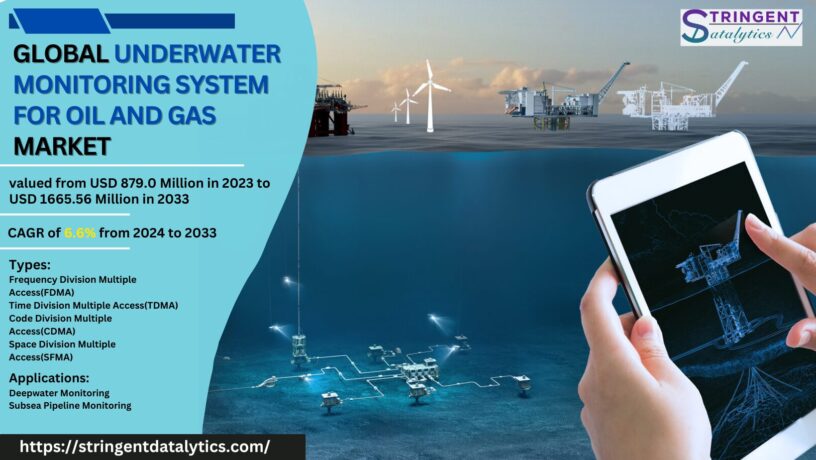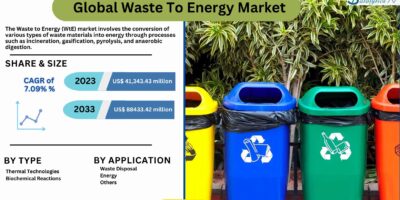The underwater monitoring system for oil and gas market was valued from USD 879.0 Million in 2023 to USD 1665.56 Million in 2033. It is estimated to advance at a CAGR of 6.6% from 2024 to 2033.
Introduction
The underwater monitoring system for oil and gas is a critical component in the exploration, production, and operational management of offshore hydrocarbon resources. These systems are designed to ensure the safety, efficiency, and environmental compliance of underwater operations by providing real-time data and analytics on various underwater conditions. This comprehensive overview delves into the components, applications, market dynamics, key players, challenges, and future trends of the underwater monitoring system market in the oil and gas industry.
Components of Underwater Monitoring Systems
Sensors and Detectors
- Pressure Sensors: Measure underwater pressure to monitor well integrity and structural health.
- Temperature Sensors: Track temperature variations to ensure the stability of operations and prevent equipment failure.
- Acoustic Sensors: Utilize sound waves to detect leaks, monitor underwater construction, and assess seabed conditions.
- Chemical Sensors: Detect the presence of hydrocarbons, gases, and other chemicals to identify leaks and spills.
Communication Systems
- Subsea Cables: Provide high-speed data transmission between underwater sensors and surface control systems.
- Acoustic Modems: Enable wireless communication for data transfer in deepwater environments where cables are impractical.
- Satellite Links: Facilitate data relay from offshore platforms to onshore control centers for real-time monitoring.
Data Acquisition and Processing Units
- Data Loggers: Collect and store sensor data for analysis and reporting.
- Control Units: Process raw data and convert it into actionable insights for operational decision-making.
- Software Platforms: Offer visualization, analytics, and reporting tools to interpret underwater data.
Power Supply Systems
- Battery Packs: Provide autonomous power to underwater sensors and devices.
- Hydraulic Power Units: Supply power to subsea control systems and actuators.
- Renewable Energy Sources: Utilize solar, wave, or tidal energy to support long-term underwater monitoring operations.
Applications of Underwater Monitoring Systems
Exploration and Drilling
- Seismic Surveys: Use acoustic sensors to map subsurface structures and identify potential hydrocarbon reserves.
- Drilling Operations: Monitor pressure, temperature, and chemical composition to ensure safe and efficient drilling processes.
Production and Operations
- Flow Assurance: Monitor pipeline conditions to prevent blockages and maintain steady hydrocarbon flow.
- Leak Detection: Use chemical and acoustic sensors to identify and locate leaks in subsea infrastructure.
- Corrosion Monitoring: Track the integrity of pipelines and equipment to prevent failures due to corrosion.
Environmental Monitoring
- Marine Life Impact: Assess the impact of oil and gas operations on marine ecosystems and ensure compliance with environmental regulations.
- Pollution Control: Monitor water quality and detect contaminants to minimize environmental impact.
Safety and Risk Management
- Structural Health Monitoring: Ensure the integrity of subsea installations and infrastructure to prevent accidents and failures.
- Emergency Response: Provide real-time data for quick decision-making in case of spills, leaks, or other emergencies.
Market Dynamics
Drivers
Increasing Offshore Exploration and Production
- Deepwater and Ultra-Deepwater Exploration: The growing demand for hydrocarbons is driving exploration in deeper waters, necessitating advanced monitoring systems to manage the associated risks and challenges.
- Expansion of Subsea Infrastructure: The development of new offshore fields requires extensive subsea infrastructure, boosting the demand for comprehensive monitoring solutions.
Regulatory and Environmental Compliance
- Stringent Regulations: Governments and regulatory bodies are imposing stricter environmental and safety regulations on offshore operations, increasing the need for reliable monitoring systems.
- Environmental Concerns: Rising awareness of the environmental impact of oil and gas activities is driving the adoption of monitoring systems to mitigate risks and ensure sustainable operations.
Restraints
High Initial Investment
- Cost of Deployment: The deployment of underwater monitoring systems involves significant capital expenditure, including the cost of sensors, communication infrastructure, and installation.
- Operational Costs: Ongoing maintenance and operation of these systems can also be costly, potentially limiting market growth.
Technical Challenges
- Harsh Underwater Conditions: The deep-sea environment poses technical challenges, including high pressure, low temperatures, and corrosive conditions that can affect the performance and durability of monitoring systems.
- Data Transmission Issues: Ensuring reliable data transmission in remote and deepwater locations can be challenging, requiring robust communication solutions.
Market Trends
Digitalization and Automation
The integration of digital technologies and automation in underwater monitoring systems is driving efficiency and reducing operational costs. Advanced data analytics, machine learning, and IoT are enabling predictive maintenance, real-time monitoring, and enhanced decision-making capabilities.
Focus on Sustainability
The oil and gas industry is increasingly focusing on sustainability, driving the adoption of monitoring systems that minimize environmental impact. Technologies for detecting and preventing spills, monitoring marine life, and reducing emissions are gaining prominence.
Development of Autonomous Systems
The development of autonomous underwater vehicles (AUVs) and remotely operated vehicles (ROVs) equipped with advanced sensors and communication systems is revolutionizing underwater monitoring. These autonomous systems can perform complex monitoring tasks with minimal human intervention, enhancing operational efficiency and safety.
Collaboration and Partnerships
Collaboration between technology providers, oil and gas companies, and regulatory bodies is fostering innovation and driving the development of integrated monitoring solutions. Partnerships with academic institutions and research organizations are also contributing to advancements in monitoring technologies.
Increased Investment in R&D
Significant investments in research and development are driving innovations in sensor technology, communication systems, and data analytics. Companies are focusing on developing robust and reliable monitoring solutions that can operate effectively in harsh underwater environments.
Receive the FREE Sample Report of Underwater Monitoring System for Oil and Gas Market Research Insights @ https://stringentdatalytics.com/sample-request/underwater-monitoring-system-for-oil-and-gas-market/15159/
Market Segmentations:
Global Underwater Monitoring System for Oil and Gas Market: By Company
Schlumberger-OneSubea
Kongsberg Maritime
Teledyne Marine
SONARDYNE
Fugro
Ocean Sonics
DSPComm
KCF Technologies
Mitcham Industries
Global Underwater Monitoring System for Oil and Gas Market: By Type
Frequency Division Multiple Access(FDMA)
Time Division Multiple Access(TDMA)
Code Division Multiple Access(CDMA)
Space Division Multiple Access(SFMA)
Global Underwater Monitoring System for Oil and Gas Market: By Application
Deepwater Monitoring
Subsea Pipeline Monitoring
Regional Analysis of Global Underwater Monitoring System for Oil and Gas Market
All the regional segmentation has been studied based on recent and future trends, and the market is forecasted throughout the prediction period. The countries covered in the regional analysis of the Global Underwater Monitoring System for Oil and Gas market report are U.S., Canada, and Mexico in North America, Germany, France, U.K., Russia, Italy, Spain, Turkey, Netherlands, Switzerland, Belgium, and Rest of Europe in Europe, Singapore, Malaysia, Australia, Thailand, Indonesia, Philippines, China, Japan, India, South Korea, Rest of Asia-Pacific (APAC) in the Asia-Pacific (APAC), Saudi Arabia, U.A.E, South Africa, Egypt, Israel, Rest of Middle East and Africa (MEA) as a part of Middle East and Africa (MEA), and Argentina, Brazil, and Rest of South America as part of South America.
Click to Purchase Underwater Monitoring System for Oil and Gas Market Research Report @ https://stringentdatalytics.com/purchase/underwater-monitoring-system-for-oil-and-gas-market/15159/?license=single
Opportunities
Technological Advancements
- Innovative Sensor Technologies: Advancements in sensor technology, including improved sensitivity and durability, are enhancing the capabilities of underwater monitoring systems.
- IoT and AI Integration: The integration of Internet of Things (IoT) devices and artificial intelligence (AI) is enabling more sophisticated data analysis and predictive maintenance capabilities.
Emerging Markets
- Expanding Offshore Activities: Emerging markets, particularly in Asia-Pacific, Latin America, and Africa, are witnessing increased offshore exploration and production activities, creating new opportunities for market growth.
- Local Partnerships and Collaborations: Collaborations with local companies and governments can facilitate market entry and expansion in these regions.
Challenges
Environmental and Safety Risks
- Operational Hazards: Underwater monitoring systems must operate reliably in hazardous environments, where equipment failure can have serious safety and environmental consequences.
- Risk of Spills and Leaks: Despite monitoring efforts, the risk of spills and leaks remains a significant challenge, necessitating continuous improvement in detection and response capabilities.
Supply Chain Disruptions
- Component Availability: Supply chain disruptions, such as shortages of critical components, can impact the production and deployment of monitoring systems.
- Logistical Challenges: Transporting and installing monitoring systems in remote offshore locations can be logistically complex and costly.
About Stringent Datalytics
Stringent Datalytics offers both custom and syndicated market research reports. Custom market research reports are tailored to a specific client’s needs and requirements. These reports provide unique insights into a particular industry or market segment and can help businesses make informed decisions about their strategies and operations.
Syndicated market research reports, on the other hand, are pre-existing reports that are available for purchase by multiple clients. These reports are often produced on a regular basis, such as annually or quarterly, and cover a broad range of industries and market segments. Syndicated reports provide clients with insights into industry trends, market sizes, and competitive landscapes. By offering both custom and syndicated reports, Stringent Datalytics can provide clients with a range of market research solutions that can be customized to their specific needs.
Reach US
Stringent Datalytics
+1 346 666 6655
Social Channels:




Leave a Reply